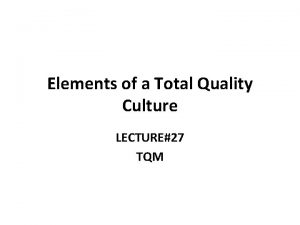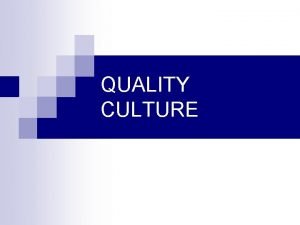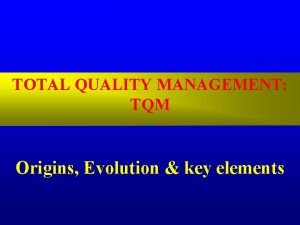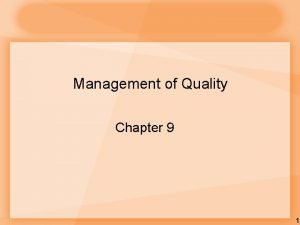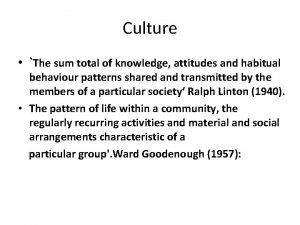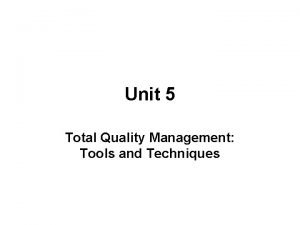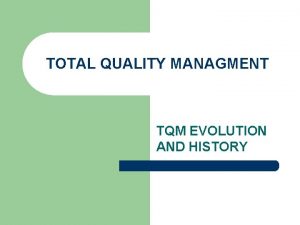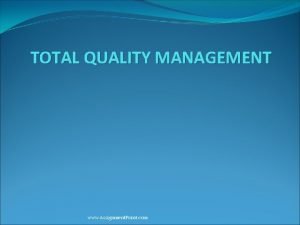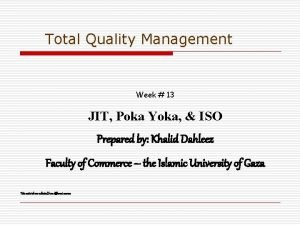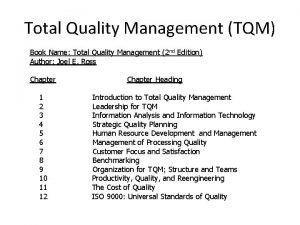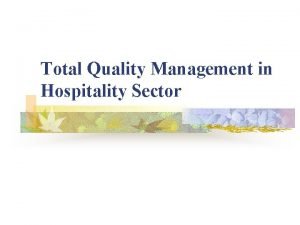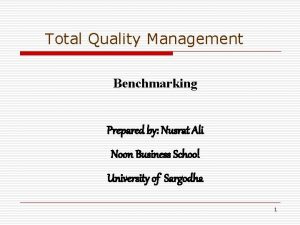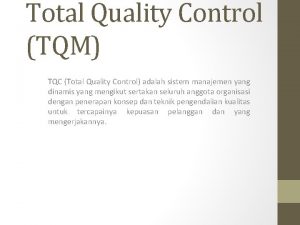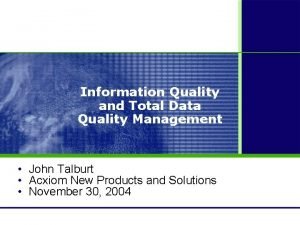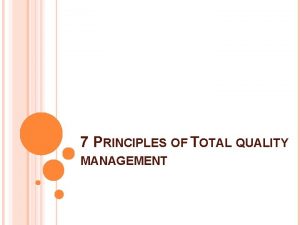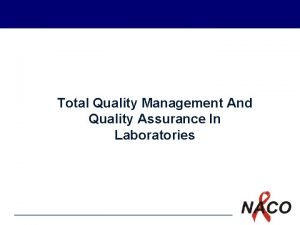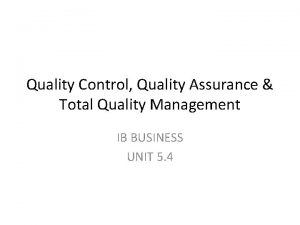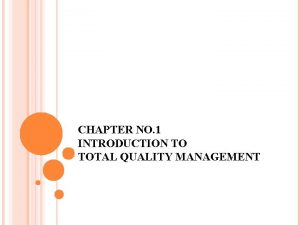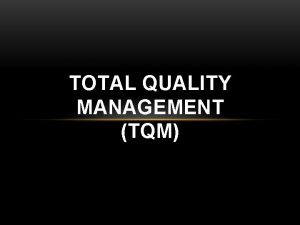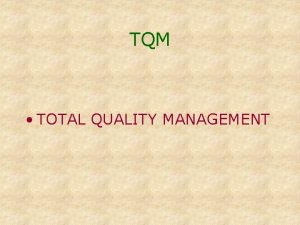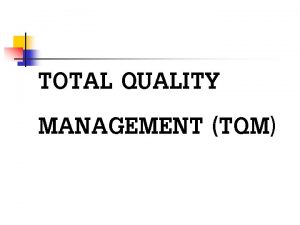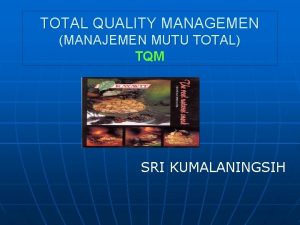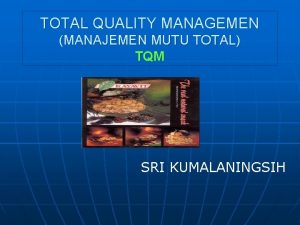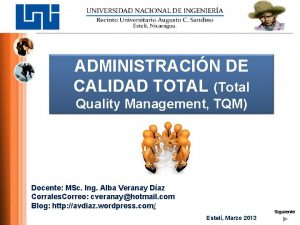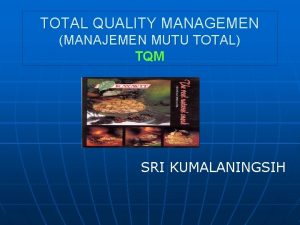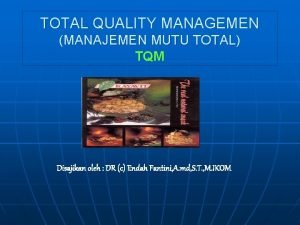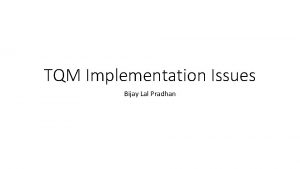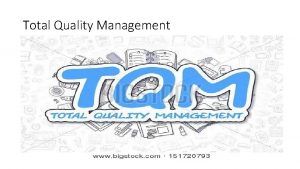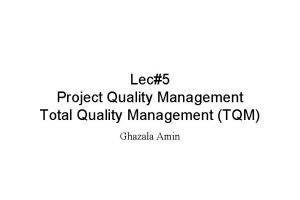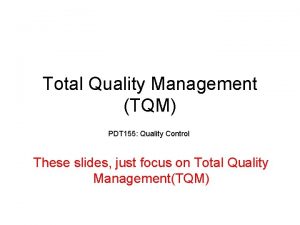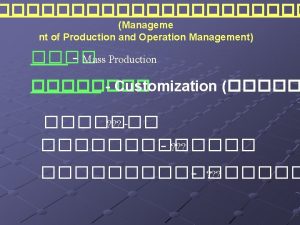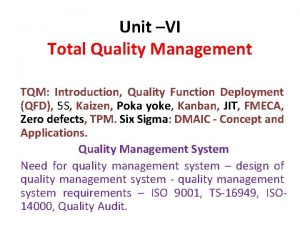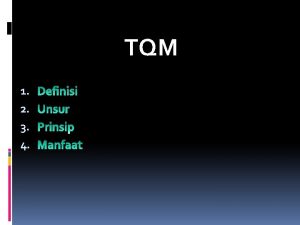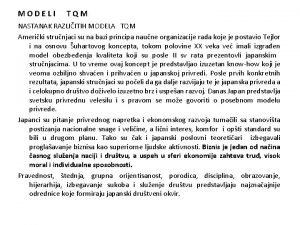Elements of a Total Quality Culture LECTURE27 TQM































- Slides: 31

Elements of a Total Quality Culture LECTURE#27 TQM

The roles of a Quality Leader • Underlying the concept of quality leadership are some clear imperatives for managers who aspire to quality leadership. • First, they must establish a vision. • Second, they must live the values. • Third, they must lead the improvement efforts. Let’ examine each of these in turn. 2

Establish a Vision • A vision is a vivid concept of what an organization could be. It is a striking depiction of possibilities, of potential. • It is a dream, both in the sense of being desirable and in the sense of being a long ay from the current reality, but it is not an “impossible dream. ” • A vision should be clear and exciting to an organization’s employees. • It should be linked to customers’ needs and convey a general strategy for achieving the mission. • To be quality leaders, managers must establish a vision for and in their organization. • “Establishing” a vision implies both the intellectual and emotional work of conceiving the vision and the interpersonal and managerial work of communicating the vision to the organization and leading employees to embrace it. 3

Establish a Vision • Jane Carroll, president of The Forum Corporation, Europe/Asia, emphasizes the visionary role of leadership for quality, which she calls focus. • She believes that most managers do not understand the need for a quality vision and their personal involvement in establishing it: • “In our experience, very few CEOs have a real sense of what their role is in the quality improvement process. It goes far beyond simply being a cheerleader and handing out an occasional award. Top management has to provide the proper focus for the organization. This is not something that can be delegated. ” 4

Establish a Vision • Putting together a vision is hard work, but quality leaders do not have to do it alone. • They can draw upon the talents and imagination of all the members of their organizations in developing their vision. • In fact, in many organizations, people are walking around with “mini-visions” of their own that sound like “if only we could [do something they have been told can’t be done], things would be so much better around here. ” • The raw material for a vision may be all around leaders in the organization. • The first step may be simply listening for it. • Leaders who are open to the ideas of people throughout the organization will be much better prepared to develop a vision that people will accept. 5

Establish a Vision • In the current competitive environment, if a given organization is not pursuing a customer-oriented vision, competing organizations probably are and are planning to use their vision to win over the competition’s customers (or are already doing so). • This is why a quality vision is such a crucial first step in quality leadership. • An organization with no vision about how to create long-term customer loyalty has little chance of survival (unless, of course, it’s a monopoly). • The second part of establishing a vision is instilling it in all the members of the organization. • This will be a lot easier if many people were involved in the first part of the process, and the leader doesn’t act like coming down the from the skies. 6

Live the Values • Pursuing the quality vision commits the organization to living by a set of values such as devotion to customers, continuous improvement, and teamwork. • A manager who hopes the organization will embrace and live by these values must live them to the utmost. • Manager’s actions can symbolize their commitment to qualityoriented values in many concrete ways. • For example, they can attend training programs on various aspects of quality, instead of just sending others. • They can practice continuous improvement in processes that they control, such as strategic planning and capital budgeting. • Perhaps most importantly, they can provide adequate funding for quality efforts. • So that TQ will not be the “poor cousin” to other business issues. 7

Lead Continuous Improvement • Beyond establishing vision for the organization and expressing quality values through their decisions and actions, quality-oriented leaders must lead the continuous process improvement efforts that are the meat and potatoes of total quality management. • All of the vision and values in the world are worthless if the organization is not continuously making strides to improve its performance in the eyes of customers. • Visions of world-class quality and competitiveness can only be achieved if an organization keeps finding ways to do things a little better and a little faster. • Leaders must be at the center of these efforts. 8

Lead Continuous Improvement • “Managers are sometime reluctant to take an active role in the organization’s improvement efforts for fear of dominating or undercutting their newly empowered workers. • Like many aspects of management, this is a question of balance, but it is mistake for managers to remain uninvolved in process improvement efforts. ” 9

Lead Continuous Improvement • There a number of ways for managers to lead continuous improvement, and which ones make the most sense will depend on the specific organization. • One option already mentioned is for leaders t lead by example, by working continuously to improve the processes that they control. • For some of these processes, organizational members are among the customers, which gives management the opportunity to model for them the behaviors associated with obtaining and acting upon customer input. • If management were to streamline the capital budgeting procedure by speeding up the process and eliminating non-value-added activities, it would provide a powerful example for people to emulate. 10

Lead Continuous Improvement • A second way that managers can lead process improvement is to help organization members prioritize processes to work on. • Here managers can take advantage of their knowledge of the “big picture” and suggest avenues of improvement that are likely to have big payoffs in terms of quality improvement and customer satisfaction. • Third way is to inspire people to do things they do not believe they can do. Motorola set aggressive goals of reducing defects per unit of output in ever operation by 100 -fold in four years and reducing cycle time by 50 percent each year. • One of Hewlett-Packard’s goals is to reduce the interval between product concept and investment payback by one-half in five years. • The 3 M Company seeks to generate 25 percent of sales from products les than two years old. • To promote such “stretch goals, ” leaders provide the resources and support necessary to meet them, especially training. 11

Lead Continuous Improvement • Of course, managers leading process improvement bear some responsibility for educating al their associates as to how the various processes within the company fit together. • If this is done effectively, organization members will be able eventually to set their own priorities for process improvement. • Managers can also lead this effort by removing barriers to success in process improvement. • Barriers may consist of a nettlesome standard operating procedure or a recalcitrant manager in a key position. 12

Lead Continuous Improvement • Without leadership from management, such barriers may undermine efforts at process improvement. Of course, in dealing with such barriers managers must continue to operate in a manner consistent with quality values. • For example managers who balk at changes must be treated with respect and their reservations considered seriously, even if they are eventually overruled. • One final way for managers to lead process improvement is to keep track of improvement efforts, to encourage them, and to provide recognition when key milestones are reached. 13

Management and Leadership • A recent treatment of leadership by John Kotter compares the concept of leadership to the concept of management. • According to this view, management is needed to create order amid complexity, and leadership is needed to stimulate the organizational change necessary to keep up with a changing environment. • This view avoids the simplistic ideas that management is some-how trivial, generally unnecessary, and should be replaced by leadership, and that the same person cannot practice both management and leadership. 14

Management and Leadership • Kotter differentiates leadership from management by contrasting the activities central to each. • While management begins with planning and budgeting, leadership begins with setting a direction. • Direction setting involves creating a vision of the future, as well as a set of approaches for a achieving the vision. • To promote goal achievement, management practices organizes and staffing, while leadership works on aligning people-communicating the vision and developing commitment to it. • Management achieves plans through controlling and problem solving, whereas leadership achieves its vision through motivating and inspiring. 15

Management and Leadership • Kotter’s view of leadership – similar to transformational theory – dovetails with our depiction of quality leadership. • Both focus on developing and communicating a vision. Kotter’s view of inspiring resembles our discussion of giving people values to embrace and then making sure that the leaders is practicing them. • The idea of aligning people is consistent with the idea of empowerment, because it gives people a goal, and then leaves them to move in that direction. • Our description of the role of leaders in continuous improvement is more hands-on than Kotter’s description, perhaps suggesting that some management behaviors will continue to be important to leaders in total quality organizations. 16

Strategic Planning for Quality and Advanced Quality Management Tools 17

Strategic Planning for Quality and Advanced Quality Management Tools • A firm has many options in defining its long-terms goals and objectives, the customers it wants to serve, the products and services it produces and delivers, and the design of the production and service system to meet these objectives. • Strategic planning is the process by which the members of an organization envision its future and develop the necessary procedures and operations to carry out that vision. • Strategy – the result of strategic planning – is the patter of decisions that determines and reveals a company’s goals, polices, and plans to meet the needs of its stakeholders. • An effective strategy allows a business to create a sustainable competitive advantage. 18

Strategic Planning for Quality and Advanced Quality Management Tools • Total quality relates to strategic management in that it enhances an organization's ability to gain a sustainable competitive advantage in the marketplace. • Handled properly total quality can be the most effective cost leadership and/or differentiation strategy an organization can adopt. • This is because the total quality approach is the best way to continually improve efficiency and cut costs throughout an organization's activity-cost chain, while simultaneously continually improving the features of the product or service that differentiates it in the marketplace. • Total quality can also improve an organization's chances of becoming a leader in a given market niche. 19

WHAT IS STRATEGIC MANAGEMENT? • To understand strategic management, one must first understand the concept of organizational strategy. • Strategies are defined as follows: • “Organizational strategies are the approaches adopted by organizations to ensure successful performance in the marketplace. These approaches are typically set forth in a comprehensive document called the strategic plan. ” • Strategic management is management that bases all actions, activities, and decisions on what is most likely-within an ethical framework to ensure successful performance in the marketplace. • From the strategic manager's perspective, resources are wasted unless they contribute to success in the marketplace, and the more direct the contribution, the better. 20

Quality as a Strategy The concept of strategy has different meanings to different people. James Brian Quinn characterizes strategy as follows: • “A strategy is a pattern or plan that integrates an organization’s major goals, policies, and action sequences into a cohesive whole. A well formulated strategy helps to marshal and allocate an organization’s resources into a unique and viable posture based on its relative internal competencies and shortcomings, anticipated changes in the environment, and contingent moves by intelligent opponents. ” 21

Quality as a Strategy Formal strategies contain three elements: – 1. Goals to be achieved, – 2. Policies that guide or limit action, and – 3. Action sequences, or programs, that accomplish the goals. • The traditional focus of business strategies has been on finance and marketing. • These parallel two of the principal sources of competitive advantage based on cost and differentiation. • Total quality – with a focus on people – leads to improvements in both areas. • Therefore, quality can be viewed as a strategy in itself. 22

Quality as a Strategy • The role of quality in business strategy has taken two significant steps since 1980. • First, many firms have recognized that a strategy driven by quality can lead to significant market advantages. • Second, the lines between quality strategy and generic business strategies have become blurred to the point where TQ principles are integrated into most businesses’ normal business planning; that is, TQ is a basic operating philosophy that provides the foundation for effective management. 23

• For most companies, integration of TQ into strategic business planning is the result of a natural evolution. • For most new companies – or those that have enjoyed a reasonable measure of success – quality takes a back seat to increasing sales, expanding capacity, or boosting production. • Strategic planning usually focuses on financial and marketing strategies. 24

COMPONENTS OF STRATEGIC MANAGEMENT • Strategic management consists of two interrelated activities: • (a) strategic planning and • (b) strategic execution. • These two primary components of strategic management are described in the following sections. 25

STRATEGIC PLANNING • Strategic planning is the process by which an organization answers such questions as the following: Who are we? • Where are we going? • How will we get there? • What do we hope to accomplish? • What are our strengths and weaknesses? • What are the opportunities and threats in our business environment? • Strategic planning involves developing a written plan following components: an organizational vision: an organizational mission; guiding principles; broad strategic objectives; and specific tactics, projects, or activities for achieving the broad objectives. Specific tactics, projects, and activities are often referred to as the "action plan. " 26

STRATEGIC EXECUTION • Strategic execution involves implementing strategies set forth in strategic planning, monitoring progress toward their achievement, and adjusting as necessary. • Strategic execution is implementation that achieves maximum efficiency and effectiveness. • Monitoring involves constantly checking actual performance against performance benchmarks. • Strategic monitoring answers such questions as these: Are we achieving our objectives? • This is the effectiveness question. • Are we performing as well as we needed to perform? • This is the efficiency question. • Adjusting as necessary involves making corrections when the specific strategies or tactics adopted are not producing the desired results. • Such adjustments can involve a minor tweaking of plans finding ways to overcome unexpected barriers that are encountered or even adopting a whole new set of specific strategies. 27

STRATEGIC PLANNING OVERVIEW • Strategic planning, as described previously is the process whereby organizations develop a vision, a mission, guiding principles, broad objectives, and specific strategies for achieving the broad objectives. • Before even beginning the planning process, an organization should conduct a SWOT analysis. • SWOT is the acronym for strengths, weaknesses, opportunities, and threats. • A SWOT analysis answers the following questions: What are this organization's strengths? • What are this organization's weaknesses? • What opportunities exist in this organization's business environment? • What threats exist in this organization's business environment? 28

• The steps in the strategic planning process (Following Figure) should be completed in order, because each successive step grows out of the preceding one. • The SWOT analysis provides a body of knowledge that is needed to undertake strategic planning. • The mission grows out of and supports the vision. • The guiding principles, which represent the organization's value system, guide the organization's behavior as it pursues its mission. • The broad objectives grow out of the mission and translate it into measurable terms; Specific strategies tie directly to the broad objectives. • Typically there will be two to five strategies for; each objective but this is a general guideline, not a hard and fast rule. 29

STRATEGIC PLANNING PROCESS 30

 Quality culture in tqm
Quality culture in tqm Quality culture vs traditional culture
Quality culture vs traditional culture Components of culture in business environment
Components of culture in business environment Quality management gurus
Quality management gurus Total quality management 14 points
Total quality management 14 points Tqm failure
Tqm failure Ciclo de servicio de una aerolinea
Ciclo de servicio de una aerolinea Total revenues minus total costs equals
Total revenues minus total costs equals Total revenues minus total costs equals
Total revenues minus total costs equals Total revenues minus total costs equals
Total revenues minus total costs equals Total revenue minus total expenses
Total revenue minus total expenses Total safety leadership
Total safety leadership The sum of the cultural
The sum of the cultural Total quality management tools
Total quality management tools History of quality management evolution
History of quality management evolution Tqm definition
Tqm definition Elements of iso 9000:2000
Elements of iso 9000:2000 Total quality management system
Total quality management system Tqm introduction
Tqm introduction Books on total quality management
Books on total quality management Total quality management in hospitality industry
Total quality management in hospitality industry Benchmarking in total quality management
Benchmarking in total quality management Contoh tqc
Contoh tqc Define seminar in nursing management
Define seminar in nursing management Kfc quality management
Kfc quality management Six sigma iso 9000
Six sigma iso 9000 Total data quality management
Total data quality management Total quality management toyota
Total quality management toyota Quality management is not a quick fix
Quality management is not a quick fix Total quality management in laboratory
Total quality management in laboratory Youtube.com
Youtube.com What is tqm
What is tqm
